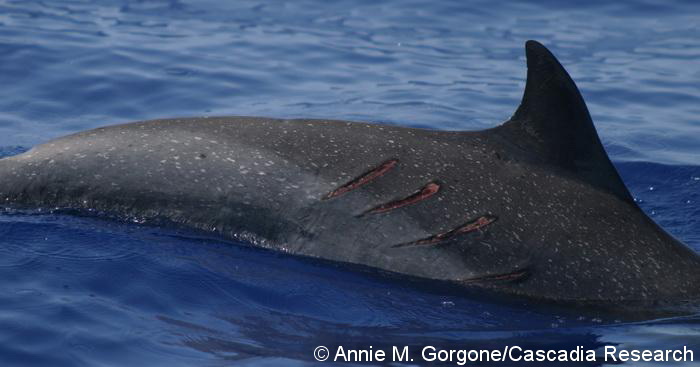
A pantropical spotted dolphin with a wound from a vessel propeller. Photo by Annie Gorgone
The most well-publicized threat to Hawaiian odontocetes is the issue of harassment and potential displacement of spinner dolphins from their resting areas by swimmers, snorkelers, and small boats. Spinner dolphins are the only species of cetacean that rests near shore in protected bays around the main Hawaiian Islands, and this behavior puts them at risk from usually well-intentioned people that will follow groups of dolphins for extended periods. While some individual spinner dolphins, particularly juveniles, may show interest in swimmers or bowride on vessels, even when the majority of the group is resting, interacting with spinner dolphins in their resting areas may result in them moving out of their preferred resting areas, potentially exposing them to greater risk of attacks by sharks and disruption of their daily cycles. But is harassment the biggest conservation threat to Hawaiian odontocetes? A list of threats, some of which are more important to certain species than others, is below.
| Threat | Species most likely to be affected |
|---|---|
| Hook ingestion | false killer whales, bottlenose dolphins, rough-toothed dolphins, pantropical spotted dolphins, spinner dolphins, short-finned pilot whales, pygmy killer whales |
| Navy sonar | beaked whales, dwarf sperm whales, melon-headed whales, possibly others |
| Vessel collisions | short-finned pilot whales, sperm whales, pantropical spotted dolphins, possibly others |
| Reduction in prey base | false killer whales, possibly bottlenose dolphins |
| Deliberate shooting | rough-toothed dolphins, melon-headed whales, bottlenose dolphins, possibly others |
| Vessel/human disturbance | pantropical spotted dolphins, spinner dolphins, short-finned pilot whales, pygmy killer whales, sperm whales, killer whales, probably other species |
| Line injuries/hooking | pantropical spotted dolphins, dwarf sperm whales, pygmy killer whales, others |
| Persistent organic pollutants | false killer whales, probably others |
| Entanglements in nearshore nets or marine debris | bottlenose dolphins, spinner dolphins, Blainville’s beaked whales, others |
Some of these threats may cause the immediate death of individuals, and some may cause injuries that could later lead to death. Other threats could make it harder to “make a living” (e.g., reduction in prey base), or could increase an individual’s susceptibility to infection or disease (e.g., persistent organic pollutants).
What puts a species most at risk?
- Low abundance
- Population structure/sub-division
- “Slow” life history (e.g., long inter-birth intervals, delayed age of first reproduction)
- Known threats
- High trophic level
- High uncertainty (e.g., about threats, abundance, population structure)
Of the 18 species of odontocetes in Hawaiian waters, until December 2012 only one was listed as Endangered under the U.S. Endangered Species Act, the sperm whale. But is it the most at risk? Sperm whales were listed as Endangered because of large reductions in abundance world-wide due to commercial whaling. Although there is no recent abundance estimate available for the North Pacific, “on the basis of total abundance, current distribution, and regulatory measures that are currently in place, it is unlikely that this stock is in danger of extinction” (Allen and Angliss 2009). The species of toothed whale most at risk in Hawai‘i was listed as Endangered in December 2012, the main Hawaiian Islands population of false killer whales. False killer whales have the lowest known abundance of any of the 18 species in Hawaiian waters, are divided into three discrete populations (an open-ocean or pelagic population, a Northwestern Hawaiian Islands population and the insular population around the main Hawaiian Islands), is slow to reproduce, is known to be threatened by a number of different anthropogenic activities, and is very high on the food web.
But many other species face a diversity of threats which could be impacting their populations in Hawaiian waters. Much of our research is focused on studying the factors that put species at risk in Hawaiian waters.
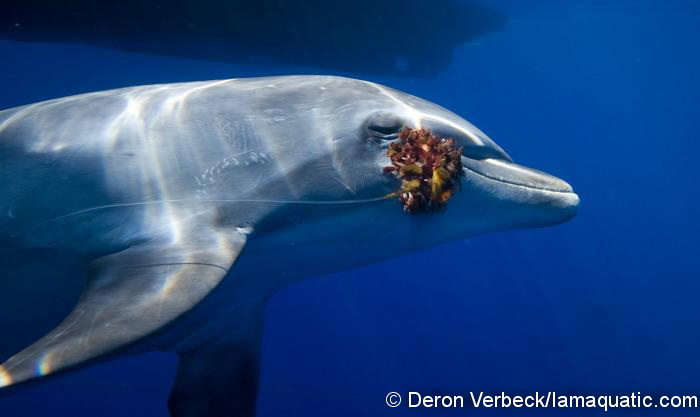
Bottlenose dolphin with hook in mouth (trailing a monofilament line) off the west coast of the island of Hawai‘i, July 5, 2009, evidence that this population does interact with local fisheries. Photo by Deron Verbeck/Iamaquatic.com. The reddish-brown material at the corner of the mouth is encrusting stalked barnacles and algae growing on the hook.
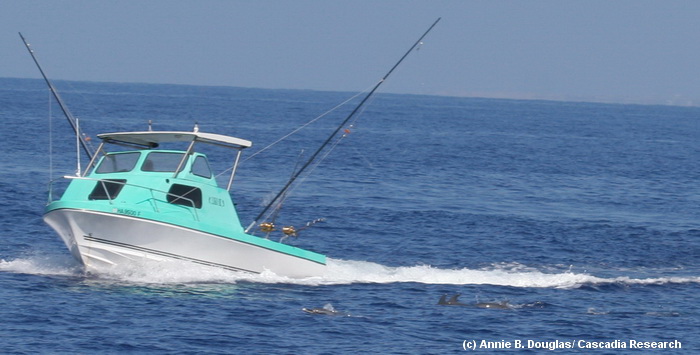
Small fishing vessels in Hawai‘i regularly “fish” spotted dolphins, repeatedly trolling through groups to try to catch associated tuna. Photo by Annie Douglas
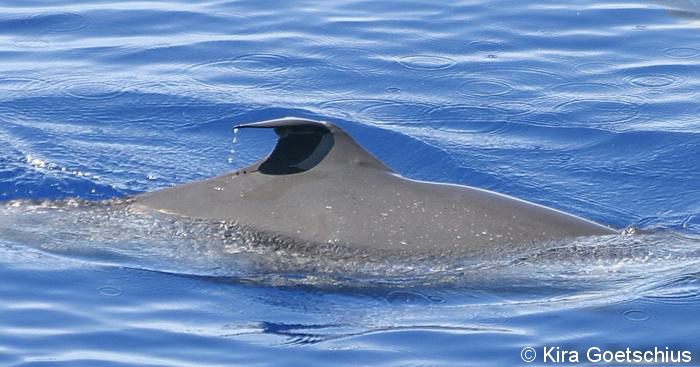
A pantropical spotted dolphin with line injuries on the dorsal fin, most likely caused by interactions with fishing gear. Photo by Kira Goetschius.
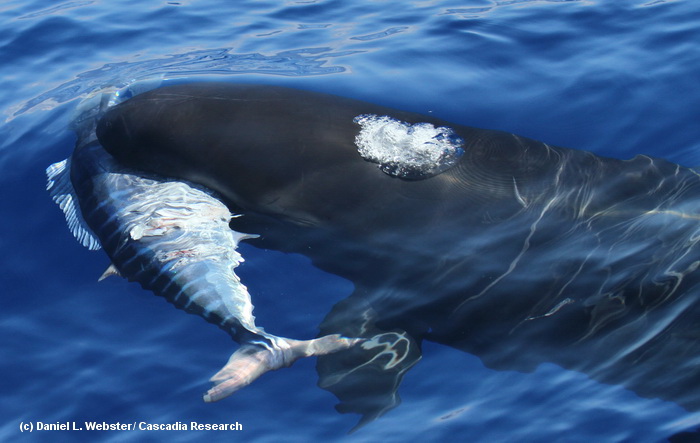
A false killer whales with an ‘ono. This species feeds primarily on large game fish, and thus may injest hooks by consuming free-swimming fish that have hooks in them, or take fish off the lines of fishermen, potentially getting entangled or killed as a result. In addition, many game fish populations have declined due to overfishing and habitat degradation, potentially affecting false killer whale populations. Photo by Daniel Webster
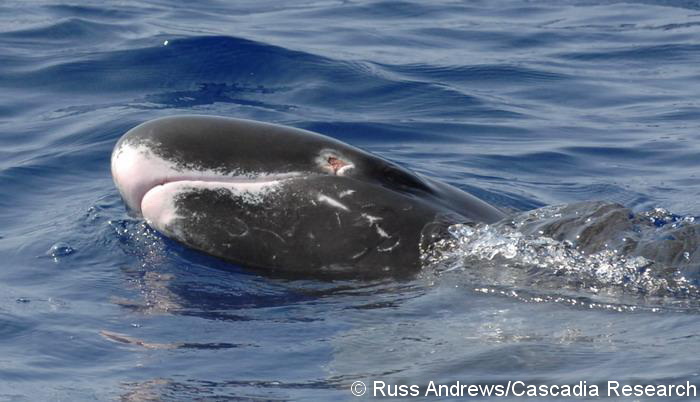
Pygmy killer whale with healing injury on mouth-line, probably due to an interaction with a line fishery. Photo by Russ Andrews.
References on Hawaiian odontocetes with more information on threats and conservation issues
- Harnish, A.E., R.W. Baird, E. Corsi, A.M. Gorgone, D. Perrine, A. Franco, C. Hankins, and E. Sepeta. 2023. Long-term associations of common bottlenose dolphins with a fish farm in Hawai‘i and impacts on other protected species. Marine Mammal Science 39(3): 794-810.
- Kratofil, M.A., A.E. Harnish, S.D. Mahaffy, E.E. Henderson, A.L. Bradford, S.W. Martin, B.A. Lagerquist, D.M. Palacios, E.M. Oleson, and R.W. Baird. 2023. Biologically important areas II for cetaceans within U.S. and adjacent waters — Hawai‘i region. Frontiers in Marine Sciences, 10:1053581.
- Baird, R.W., D.B. Anderson, M.A. Kratofil, and D.L. Webster. 2021. Bringing the right fishermen to the table: indices of overlap between endangered false killer whales and nearshore fisheries in Hawai‘i. Biological Conservation 255
- Van Cise, A.M., R.W. Baird, A.E. Harnish, J.J. Currie, S.H. Stack, T. Cullins, and A.M. Gorgone. 2021. Mark-recapture estimates suggest declines in abundance of common bottlenose dolphin stocks in the main Hawaiian Islands. Endangered Species Research 45:37-53.
- Anderson, D., R.W. Baird, A.L. Bradford, and E.M. Oleson. 2020. Is it all about the haul? Pelagic false killer whale interactions with longline fisheries in the central North Pacific. Fisheries Research 230, 105665.
- Baird, R.W., and D.L. Webster. 2020. Using dolphins to catch tuna: assessment of associations between pantropical spotted dolphins and yellowfin tuna hook and line fisheries in Hawai‘i. Fisheries Research 230, 105652.
- Kratofil, M.A., G.M. Ylitalo, S.D. Mahaffy, K.L. West and R.W. Baird. 2020. Life history and social structure as drivers of persistent organic pollutant levels and stable isotopes in Hawaiian false killer whales (Pseudorca crassidens). Science of the Total Environment 733:138880
- Harnish, A.E., J. Ault, C. Babbitt, F.M.D. Gulland, P.C. Johnson, N.L. Shaughnessy, K.A. Wood and R.W. Baird. 2019. Survival of a common bottlenose dolphin (Tursiops truncatus) calf with a presumptive gunshot wound to the head. Aquatic Mammals 45:543-548.
- Bradford, A.L., R.W. Baird, S.D. Mahaffy, A.M. Gorgone, D.J. McSweeney, T. Cullins, D.L. Webster, and A.N. Zerbini. 2018. Abundance estimates for management of endangered false killer whales in the main Hawaiian Islands. Endangered Species Research 36:297-313
- Baird, R.W., S.W. Martin, R. Manzano-Roth, D.L. Webster, and B.L. Southall. 2017. Assessing exposure and response of three species of odontocetes to mid-frequency active sonar during submarine commanders courses at the Pacific Missile Range Facility: August 2013 through February 2015. Prepared for U.S. Pacific Fleet, submitted to NAVFAC PAC by HDR Environmental, Operations and Construction, Inc., Honolulu, Hawai‘i. Download PDF copy
- Forney, K. A., B. L. Southall, E. Slooten, S. Dawson, A. J. Read, R. W. Baird, R. L. Brownell Jr. 2017. Nowhere to go: noise impact assessments for marine mammal populations with high site fidelity. Endangered Species Research doi: 10.3354/esr00820. Download PDF copy
- Baird, R.W., D. Cholewiak, D.L. Webster, G.S. Schorr, S.D. Mahaffy, C. Curtice, J. Harrison and S.M. Van Parijs. 2015. Biologically important areas for cetaceans within U.S. waters – Hawai‘i region. Aquatic Mammals 41:54-64. Download PDF copy
- Baird, R.W., S.D. Mahaffy, A.M. Gorgone, T. Cullins, D.J. McSweeney, E.M. Oleson, A.L. Bradford, J. Barlow and D.L. Webster. 2014. False killer whales and fisheries interactions in Hawaiian waters: evidence for sex bias and variation among populations and social groups. Marine Mammal Science doi: 10.1111/mms.12177. Download PDF copy
- Baird, R.W., M.B. Hanson, G.S. Schorr, D.L. Webster, D.J. McSweeney, A.M. Gorgone, S.D. Mahaffy, D. Holzer, E.M. Oleson and R.D. Andrews. 2012. Range and primary habitats of Hawaiian insular false killer whales: informing determination of critical habitat. Endangered Species Research 18:47-61. Download PDF copy
- Aschettino, J.M., R.W. Baird, D.J. McSweeney, D.L. Webster, G.S. Schorr, J.L. Huggins, K.K. Martien, S.D. Mahaffy, and K.L. West. 2011. Population structure of melon-headed whales (Peponocephala electra) in the Hawaiian Archipelago: evidence of multiple populations based on photo-identification. Marine Mammal Science doi: 10.1111/j.1748-7692.2011.00517.x Download PDF copy
- Aschettino, J.M. 2010. Population size and structure of melon-headed whales (Peponocephala electra) around the main Hawaiian Islands: evidence of multiple populations based on photographic data. M.Sc. Thesis, Hawai‘i Pacific University. 117 pp. Download PDF copy (13 MB file)
- Faerber, M.M., and R.W. Baird. 2010. Does a lack of observed beaked whale strandings in military exercise areas mean no impacts have occurred? A comparison of stranding and detection probabilities in the Canary and Hawaiian Islands. Marine Mammal Science 26:602-613 Download PDF copy. The definitive version is available at Wiley InterScience
- Baird, R.W. 2009. A review of false killer whales in Hawaiian waters: biology, status, and risk factors. Report prepared for the U.S. Marine Mammal Commission under Order No. E40475499. Download PDF copy
- Hooker, S.K., R.W. Baird, and A. Fahlman. 2009. Could beaked whales get the bends? Effects of diving behaviour and physiology on modelled gas exchange for three species: Ziphius cavirostris, Mesoplodon densirostris and Hyperoodon ampullatus. Respiratory Physiology & Neurobiology 167:235-246. Download PDF copy. The definitive version is available at doi:10.1016/j.resp.2009.04.023.
- Reeves, R.R., S. Leatherwood and R.W. Baird. 2009. Evidence of a possible decline since 1989 in false killer whales (Pseudorca crassidens) around the main Hawaiian Islands. Pacific Science 63:253-261. Download PDF copy
- Ylitalo, G.M., R.W. Baird, G.K. Yanagida, D.L. Webster, S.J. Chivers, J.L. Bolton, G.S. Schorr, and D.J. McSweeney. 2009. High levels of persistent organic pollutants measured in blubber of island-associated false killer whales (Pseudorca crassidens) around the main Hawaiian Islands. Marine Pollution Bulletin 58:1932-1937. Download PDF copy.
- Southall, B.L., R. Braun, F.M.D. Gulland, A.D. Heard, R.W. Baird, S.M. Wilkin, and T.K. Rowles. 2006. Hawaiian melon-headed whale (Peponocephala electra) mass stranding event of July 3-4, 2004. NOAA Technical Memorandum NMFS-OPR-31. Download PDF copy
- Baird, R.W., and A.M. Gorgone. 2005. False killer whale dorsal fin disfigurements as a possible indicator of long-line fishery interactions in Hawaiian waters. Pacific Science 59:593-601.Download PDF copy
Photos on this page taken under NMFS Scientific Research Permits (Nos. 731-1774 and 774-1714). All photos are copyrighted and should not be used without permission.
Last updated 2024